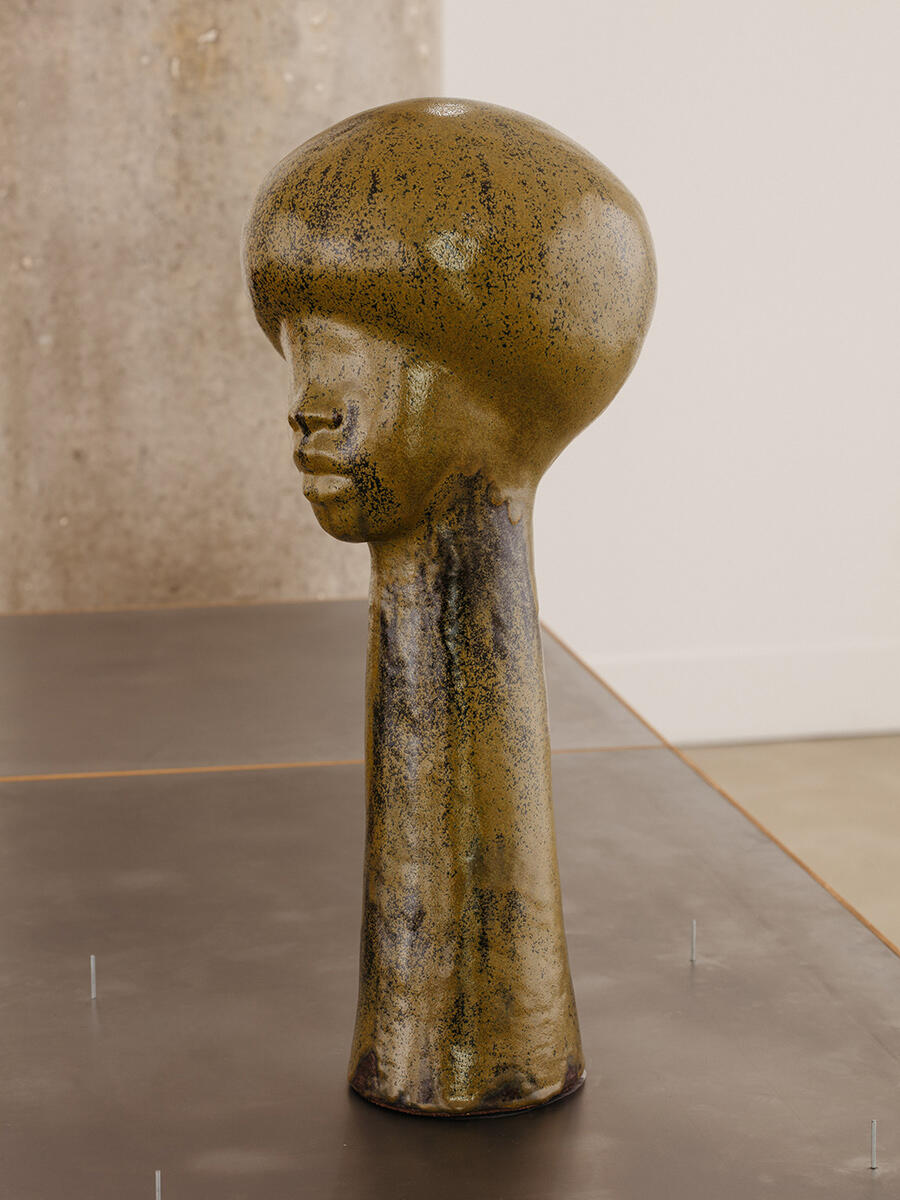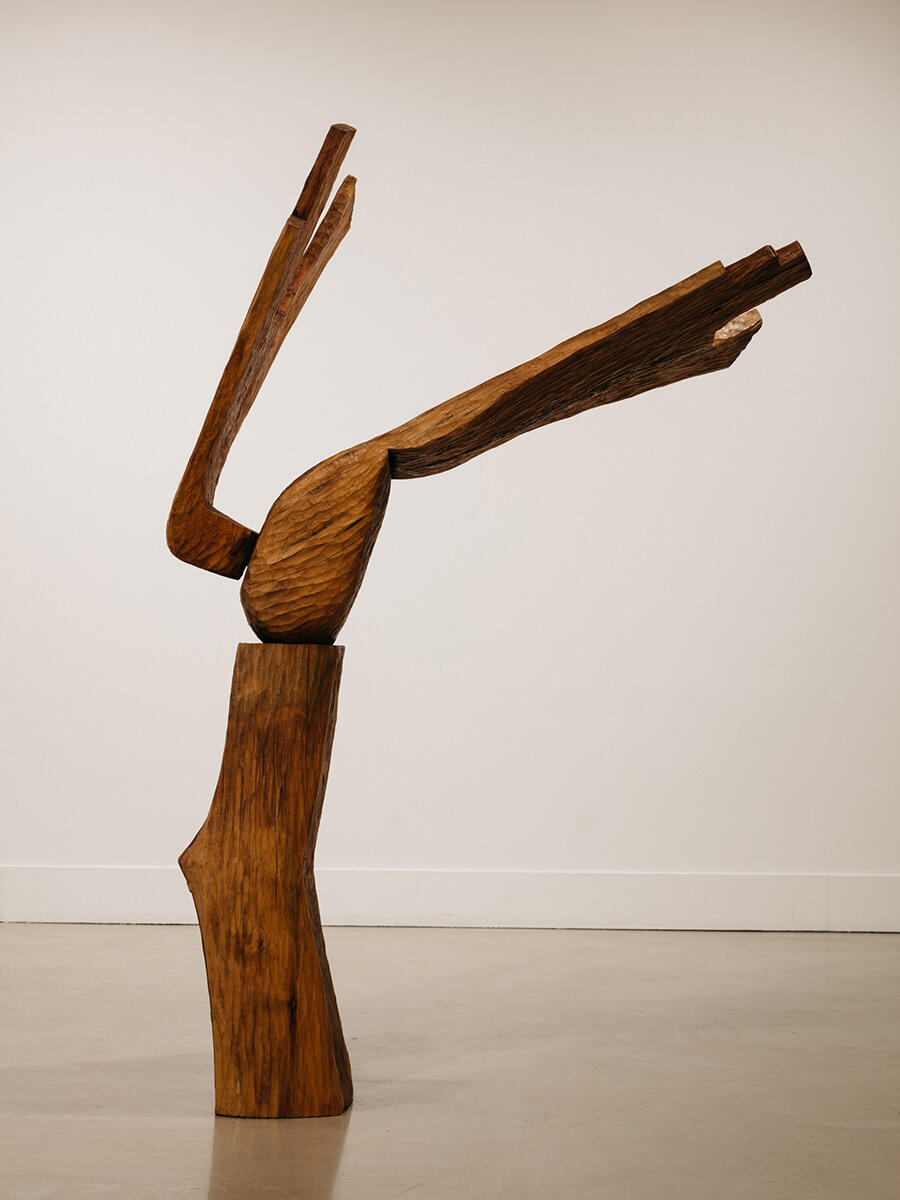‘Embodying Anew’ Is A Symphony of Black Subjectivity
At Maximillian William, a group show celebrates modernist sculpture bringing Simone Leigh and Magdalene Odundo’s anthropomorphic vessels together with Thaddeus Mosley’s Brancusian forms
At Maximillian William, a group show celebrates modernist sculpture bringing Simone Leigh and Magdalene Odundo’s anthropomorphic vessels together with Thaddeus Mosley’s Brancusian forms

In a 1993 essay for Artforum, scholar and critic bell hooks references Lorna Simpson’s photograph Waterbearer (1986) as an example of ‘subjugated knowledge’. In it, a woman, her face obscured, pours water onto the floor from two containers. Text at the bottom of the image reads: ‘They asked her to tell what happened / Only to discount her memory.’ Here, ‘subjugated knowledge’ describes the thoughts, feelings and labour of women – especially Black women. You hope the subject’s turned back is an act of defiance, that she is refusing to offer any more of herself.

The works in ‘Embodying Anew’ – a concise group show with the vitality and depth of a museum presentation – feel equally strong-willed. The exhibition brings together artworks by Simone Leigh, Thaddeus Mosley and Magdalene Odundo – artists who often have had to create in defiance of their craft and skill being discounted or pigeon-holed.
Three ceramic forms by Odundo serve to represent her 40-year career: her works feel like the beating heart of the show. Odundo graduated from the Royal College of Art in 1982 and travelled to Nigeria and Kenya to learn about various African pottery methods, including centuries-old techniques used by Gbari women in Nigeria. Clay isn’t thrown on a potter’s wheel; rather, it is painstakingly hand-coiled. The unglazed vessels are then fired at high temperatures, often more than once, which leads to a rich depth of colour: deep mahogany, shiny blacks, bronzes, rusts, striking terracottas.

Odundo’s sculptures contain anthropomorphic qualities, as though they follow the curves of a woman’s body. In a 2020 interview with J.W. Anderson, Odundo says that she thinks ‘very much of the body itself being a vessel, a shell or container’ and links this idea to the ways in which various African cultures believe bodies and objects can contain the spirits of ancestors. These sentiments are echoed in Leigh’s Stretch (GREEN) (2020), a towering, glazed sculpture of the face and neck of a Black woman, resplendent with an afro, and Mosley’s Repetitive Sentence (2015), a gravity-defying form made from walnut wood.
In a 2019 interview with The Art Newspaper, Leigh says that her work has been a ‘lifetime of critical inquiry’ and of centring Black female subjectivity. Months later, in conversation with The New York Times, she references Odundo’s practice as a key influence. Critical inquiry and Black subjectivity can be found in all three artists’ practices. Mosley, still making work at the age of 94, is self-taught; he uses wood from felled trees in Pittsburgh as his primary medium, exploring plane and volume in a way that recalls Constantin Brâncusi. Repetitive Sentence is an example of what he calls ‘animated sculpture’ and is a testament to the artist’s jazz sensibilities – it also feels like an ode to what has made and sustained him. Mosley grew up in a family of musicians; his friend, artist Sam Gilliam, refers to him as a ‘jazz critic’. Experimenting with modernist frameworks of sculpture and breaking them apart, Mosley’s work – which sits in conversation with that of artists such as Martin Puryear – tests the limits of physical possibility.

Mosley and Leigh, who will be the first Black woman to represent the US at the Venice Biennale in 2022, have rarely shown in the UK; Odundo seldom exhibits in the US. (A recent Salon 94 show was her first in New York since 1991.) To bring the three together feels like a statement of intent. Separately, the artworks implore you to return to them time and again: to follow the way the light falls and bounces shadows across the gallery; to understand their anthropomorphic qualities; to imagine the lives, musical notes and histories rippling to the surface. Collectively, the show feels like the wildest kind of jazz: it is improvisation, syncopation, scholarship, care, attention, memory. Every artwork sings – in chorus, but also in powerful singularity.
'Embodying Anew' at Maximillian William ended on 19 June.
Main image: 'Embodying Anew', 2021, installation view at Maximillian William, London. Courtesy: the artists and Maximillian William, London




















